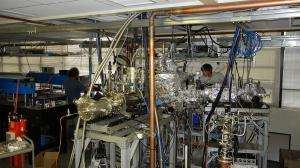Key building block of life may have come from deep space

Researchers at UH Mānoa's Department of Chemistry have provided compelling evidence that glycerol, a key molecule in the origin of Earth's living organisms, may have occurred in space more than 4 billion years ago. Glycerol represents the central building block in cells – the smallest structural and biological unit of all known living organisms on Earth.
The newly published research paper Synthesis of Prebiotic Glycerol in Interstellar Ices was authored by Professor Ralf Kaiser, and Drs. Surajit Maity and Brant M. Jones of the W.M. Keck Research Laboratory in Astrochemistry at UH Mānoa. The research details the methods used to re-create in a laboratory how glycerol could have been formed in astrophysically relevant ices by ionizing radiation in interstellar space and carried by meteorites and comets to Earth prior to the existence of life.
In an ultra-high vacuum chamber cooled down to 5 degrees above absolute zero (5 Kelvin), the Hawaiʻi team simulated icy "sand grains" coated with an alcohol – methanol. When zapped with high-energy electrons to simulate the cosmic rays in space, methanol reacted to form complex, organic compounds – specifically glycerol.
"Our hope and expectation is to propel astrobiologically related research involving the search for the molecular origin of life in our universe to the next level, ultimately leading to the production of an inventory of biorelevant molecules, which could have seeded the evolution of life as we know it," the authors wrote. This work challenges an alternative theory that glycerol and other prebiotic cell components were synthesized on Earth under hydrothermal conditions. "This requires cutting edge tunable lasers and vacuum ultraviolet light to probe the newly formed molecules," Kaiser and Jones added.
The researchers expect to define a benchmark for future sampling of distinct classes of astrobiologically relevant molecules like sugars, sugar alcohols and sugar acids. They hope to re-create nucleotides in the laboratory in next generation scattering experiments simulating conditions in the harsh environment of space. Nucleotides are a key components of ribonucleic acid implicated in the replication of living organisms.
More information: www.chem.hawaii.edu/Bil301/Kaiser%20Paper/p322.pdf
Provided by University of Hawaii at Manoa





















